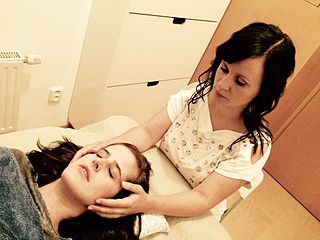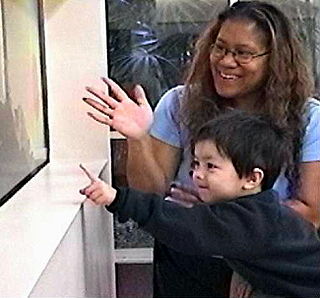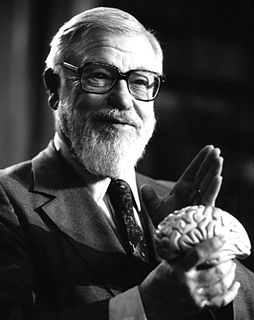
Dyslexia, also known as reading disorder, is a disorder characterized by reading below the expected level for their age. Different people are affected to different degrees. Problems may include difficulties in spelling words, reading quickly, writing words, "sounding out" words in the head, pronouncing words when reading aloud and understanding what one reads. Often these difficulties are first noticed at school. When someone who previously could read loses their ability, it is known as alexia. The difficulties are involuntary and people with this disorder have a normal desire to learn. People with dyslexia have higher rates of attention deficit hyperactivity disorder (ADHD), developmental language disorders, and difficulties with numbers.

Craniosacral therapy (CST) or cranial osteopathy is a form of alternative therapy that uses gentle touch to palpate the synarthrodial joints of the cranium. CST is a pseudoscience, and its practice has been characterized as quackery. It is based on fundamental misconceptions about the physiology of the human skull and is promoted as a cure-all for a variety of health conditions.

Stephen Joel Barrett is an American retired psychiatrist, author, co-founder of the National Council Against Health Fraud (NCAHF), and the webmaster of Quackwatch. He runs a number of websites dealing with quackery and health fraud. He focuses on consumer protection, medical ethics, and scientific skepticism.
Quackwatch is a United States-based website, self-described as a "network of people" founded by Stephen Barrett, which aims to "combat health-related frauds, myths, fads, fallacies, and misconduct" and to focus on "quackery-related information that is difficult or impossible to get elsewhere". Since 1996 it has operated the alternative medicine watchdog website quackwatch.org, which advises the public on unproven or ineffective alternative medicine remedies. The site contains articles and other information criticizing many forms of alternative medicine.
bibic is a small charitable organization based in the United Kingdom that supports children, young people and their families deal with a number of different conditions. The charity was founded by the late Keith Pennock who had a daughter with a learning disability. The work was derived from Glenn Doman's The Institutes for The Achievement of Human Potential (IAHP) in Philadelphia, USA.
Vision therapy (VT), or behavioral optometry, is an umbrella term for alternative medicine treatments using eye exercises, based around the pseudoscientific claim that vision problems are the true underlying cause of learning disabilities, particularly in children. Vision therapy has not been shown to be effective using scientific studies, except for helping with convergence insufficiency. Most claims—for example that the therapy can address neurological, educational, and spatial difficulties—lack supporting evidence. Neither the American Academy of Pediatrics nor the American Academy of Ophthalmology support the use of vision therapy.
The following outline is provided as an overview of and topical guide to autism:
The Institutes for The Achievement of Human Potential (IAHP), founded in 1955 by Glenn Doman and Carl Delacato, provide literature on and teaches a controversial patterning therapy, which the Institutes promote as improving the "neurologic organization" of "brain injured" and mentally impaired children through a variety of programs, including diet and exercise. The Institutes also provides extensive early-learning programs for "well" children, including programs focused on reading, mathematics, language, and physical fitness. It is headquartered in Philadelphia, Pennsylvania with offices and programs offered in several other countries. Pattern therapy for patients with neuromuscular disorders was first developed by neurosurgeon Temple Fay in the 1940s. Patterning has been widely criticized and multiple studies have found the therapy ineffective.

Autism therapies are a wide variety of therapies that attempt to improve the quality of life of autistic people and lessen the deficits and problematic behaviours colloquially associated with autism spectrum disorder (ASD). These methods of therapy also seek the increase of functional independence in autistic people. Autism can be described as social and language disability that is detected in most children as early as the of 18 months old. There is no known cause or cure for autism but treatment and therapies are suggested. None of these therapies eliminate autism within someone, let alone to a high degree of viability. Autistic children grow up to become autistic adults at risk of burnout and PTSD inflicted during childhood and adolescence, often overlooked by those who prioritize the elimination of autism over the common well being of autistic people. Treatment is typically catered to the person's needs. Treatments fall into two major categories: educational interventions and medical management. Training and support are also given to families of those with ASD.
Auditory integration training (AIT), is a procedure pioneered in France by Guy Bérard, who promoted it as a cure for clinical depression and suicidal tendencies, along with what he said were very positive results for dyslexia and autism, although there has been very little empirical evidence regarding this assertion. It typically involves 20 half-hour sessions over 10 days listening to specially filtered and modulated music. It was used in the early 1990s as a treatment for autism; it has been promoted as a treatment for ADHD, depression, and a wide variety of other disorders. AIT has not met scientific standards for efficacy that would justify its use as a treatment for any condition.
Energy medicine is a branch of alternative medicine based on a pseudo-scientific belief that healers can channel "healing energy" into a patient and effect positive results. Practitioners use a number of names including various synonyms for medicine and sometimes use the word vibrational instead of or in concert with energy. In most cases there is no empirically measurable energy involved: the term refers instead to so-called subtle energy. Practitioners may classify practice as hands-on, hands-off, and distant where the patient and healer are in different locations. Many schools of energy healing exist using many names: for example, biofield energy healing, spiritual healing, contact healing, distant healing, therapeutic touch, Reiki or Qigong.
Health is the state of complete physical, mental, and social well-being and a positive concept emphasizing social and personal resources, as well as physical capacities. This article lists major topics related to personal health.

Equine-assisted therapy (EAT) encompasses a range of treatments that involve activities with horses and other equines to promote human physical and mental health. The use of EAT has roots in antiquity, and EAT applies to physical health issues in modern form dates to the 1960s. Modern use of horses for mental health treatment dates to the 1990s. Systematic review of studies of EAT as applied to physical health date only to about 2007, and a lack of common terminology and standardization has caused problems with meta-analysis. Due to a lack of high-quality studies assessing the efficacy of equine-assisted therapies for mental health treatment, concerns have been raised that these therapies should not replace or divert resources from other evidence-based mental health therapies.
Alternative therapies for developmental and learning disabilities include a range of practices used in the treatment of dyslexia, ADHD, autism spectrum disorders, Down syndrome and other developmental and learning disabilities. Treatments include changes in diet, dietary supplements, biofeedback, chelation therapy, homeopathy, massage and yoga. These therapies generally rely on theories that have little scientific basis, lacking well-controlled, large, randomized trials to demonstrate safety and efficacy; small trials that have reported beneficial effects can be generally explained by the ordinary waxing and waning of the underlying conditions.
Mental disorders diagnosed in childhood are divided into two categories: childhood disorders and learning disorders. These disorders are usually first diagnosed in infancy, childhood, or adolescence, as laid out in the DSM-IV-TR and in the ICD-10. The DSM-IV-TR includes ten subcategories of disorders including mental retardation, Learning Disorders, Motor Skills Disorders, Communication Disorders, Pervasive Developmental Disorders, Attention-Deficit and Disruptive Behavior Disorders, Feeding and Eating Disorders, Tic Disorders, Elimination Disorders, and Other Disorders of Infancy, Childhood, or Adolescence.
Speech and language impairment are basic categories that might be drawn in issues of communication involve hearing, speech, language, and fluency.
Harold Levinson is an American psychiatrist and author, known for developing his cerebellar theory of treating dyslexia.

Psychomotor patterning, rarely referred to as the Doman-Delacato technique, is a pseudoscientific approach to the treatment of intellectual disabilities, brain injury, learning disabilities, and other cognitive diseases. The treatment is based on the largely discredited hypothesis that ontogeny recapitulates phylogeny. The method assumes that intellectual disabilities results from the failure of an individual to develop properly through the phylogenetic stages, and treatment primarily focuses on non-invasive physical therapy in each of these stages. In one such stage, the homolateral stage, a healthy child typically crawls by turning the head to one side while extending the arm and leg of the opposite side. The patterning treatment is applied to those unable to perform this motion, and involves passive intervention by 4-5 adults who assists the child in an effort to impose or induce the proper pattern onto the central nervous system. The therapy normally lasts for 5 minutes and is repeated at least 4 times a day. Full treatment programs typically contain a range of exercises combined with sensory stimulation, breathing exercises designed to increase oxygen flow to the brain, and systematic restriction and facilitation designed to promote hemispheric dominance.






